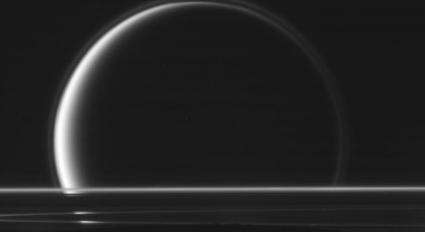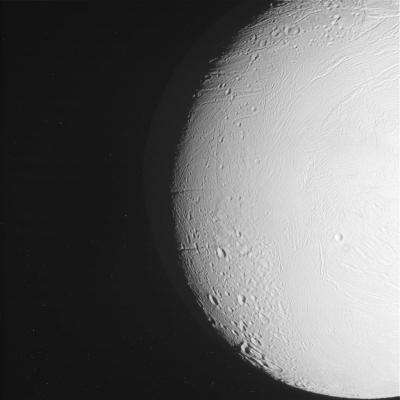Cassini Heading to Titan after Tagging Enceladus

(PhysOrg.com) -- NASA's Cassini spacecraft is on its way to a flyby of Saturn's largest moon, Titan, after capturing some stunning images of Enceladus. One view shows the hazy outline of Titan behind Saturn's rings, with the dark curve of Enceladus at the bottom.
In other images, Enceladus put its craggy face forward, exhibiting some of the fractures and cratering that have made the Saturnian moon a favorite of both planetary scientists and outer-planet mission groupies. A view of Enceladus' terminator was taken by NASA's Cassini spacecraft on May 18 from approximately 75,000 kilometers (46,500 miles) away.
Cassini sent back numerous images May 18, 2010, as it finished the first leg of its planned double flyby. Cassini passed within about 435 kilometers (270 miles) of the Enceladus surface.
Cassini is heading toward Titan for a flyby that occurs in the late evening May 19 Pacific time, which is in the early hours of May 20 UTC. Because of a fortuitous cosmic alignment, Cassini can catch glimpses of these two contrasting worlds within less than 48 hours, with no maneuver in between.
The main scientific goal at Enceladus was to watch the sun play peek-a-boo behind the water-rich plume emanating from the moon's south polar region. Scientists using the ultraviolet imaging spectrograph will be able to use the flickering light to measure whether there is molecular nitrogen in the plume. Ammonia has already been detected in the plume, and scientists know heat can decompose ammonia into nitrogen molecules. Determining the amount of molecular nitrogen in the plume will give scientists clues about thermal processing in the moon's interior.

The Cassini-Huygens mission is a cooperative project of NASA, the European Space Agency and the Italian Space Agency.
More raw images from the Enceladus flyby, dubbed "E10," are available at: saturn.jpl.nasa.gov/photos/raw/
Provided by JPL/NASA




















